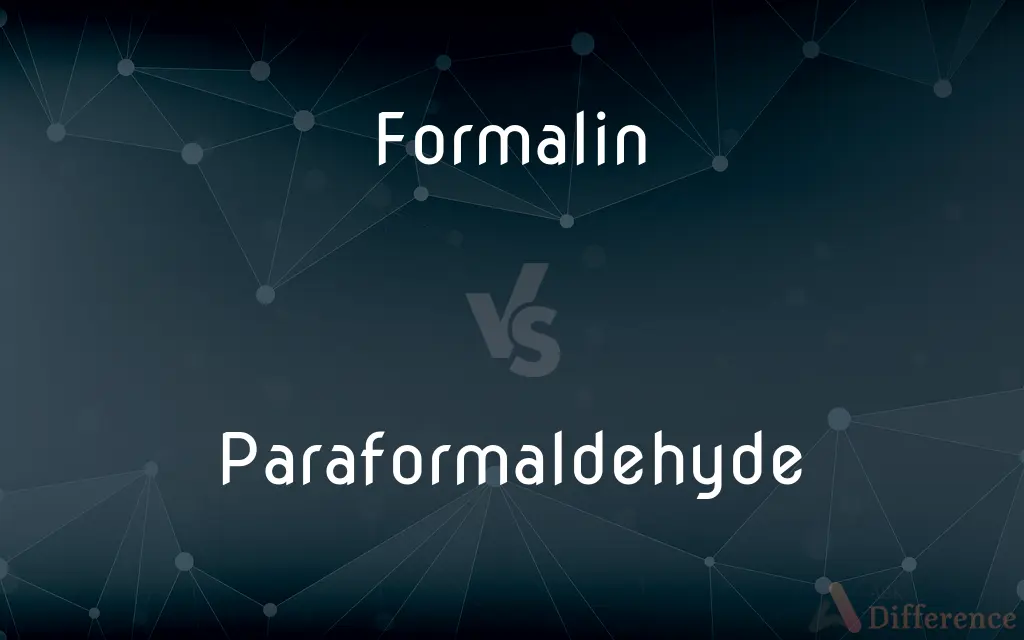Formalin vs. Paraformaldehyde — What's the Difference?
By Tayyaba Rehman & Maham Liaqat — Updated on May 4, 2024
Formalin is a liquid solution containing about 37% formaldehyde gas, used as a preservative and disinfectant, while paraformaldehyde is a solid polymer of formaldehyde, utilized mainly in its depolymerized form.

Difference Between Formalin and Paraformaldehyde
Table of Contents
ADVERTISEMENT
Key Differences
Formalin is primarily a water-based solution that includes approximately 37% formaldehyde and up to 15% methanol to prevent polymerization. Whereas, paraformaldehyde is a dry, white polymeric solid form of formaldehyde, typically used in a depolymerized form to yield formaldehyde gas when needed.
In practical applications, formalin is extensively used in histology and pathology for tissue fixation and preservation, ensuring that biological structures are maintained for examination. On the other hand, paraformaldehyde is often used in the preparation of samples for electron microscopy, where a more controlled release of formaldehyde is required.
Safety measures with formalin involve dealing with its potent fumes and its potential as a health hazard, necessitating special handling and storage conditions. Conversely, paraformaldehyde, while also hazardous, poses risks primarily when heated or in situations that cause it to depolymerize and release formaldehyde gas.
Formalin's use extends beyond the laboratory; it's also employed in embalming and as a disinfectant due to its antimicrobial properties. Paraformaldehyde does not find similar use in disinfection; its primary role is restricted to laboratory settings as a fixative or for other specialized chemical processes.
In terms of storage and stability, formalin is relatively stable and can be stored over long periods if sealed properly to avoid oxidation and evaporation. Paraformaldehyde, while stable as a solid, requires careful handling to prevent it from forming a hazardous environment when it decomposes into formaldehyde gas.
ADVERTISEMENT
Comparison Chart
Form
Aqueous solution
Dry, solid polymer
Composition
37% formaldehyde, up to 15% methanol, water
Polymeric formaldehyde
Primary Use
Tissue preservation, disinfection
Laboratory fixative, sample preparation
Handling Safety
Toxic fumes, requires ventilation
Hazardous when heated, releases formaldehyde gas
Stability and Storage
Stable, requires sealing to prevent evaporation
Stable solid, precautions against depolymerization
Compare with Definitions
Formalin
Aqueous solution of formaldehyde.
Formalin is used to preserve biological specimens.
Paraformaldehyde
Solid polymer of formaldehyde.
Paraformaldehyde is used in its powdered form in labs.
Formalin
Used in embalming.
Formalin's antimicrobial properties make it suitable for embalming.
Paraformaldehyde
Common in electron microscopy.
Paraformaldehyde ensures detailed cellular structures are visible in electron microscopy.
Formalin
Acts as a disinfectant.
Hospitals use formalin to disinfect surgical instruments.
Paraformaldehyde
Requires controlled conditions to prevent risks.
Paraformaldehyde handling demands stringent safety measures.
Formalin
Suitable for long-term storage.
Stored properly, formalin can be effective for many years.
Paraformaldehyde
Used primarily in depolymerized form.
Heating paraformaldehyde will release formaldehyde for use.
Formalin
Contains methanol to prevent polymerization.
The addition of methanol in formalin helps maintain its efficacy.
Paraformaldehyde
Not typically used for disinfection.
Unlike formalin, paraformaldehyde is not suitable for disinfecting surfaces.
Formalin
An aqueous solution of formaldehyde that is 37 percent by weight, usually also containing 10 to 15 percent methanol to prevent polymerization of the formaldehyde.
Paraformaldehyde
Paraformaldehyde (PFA) is the smallest polyoxymethylene, the polymerization product of formaldehyde with a typical degree of polymerization of 8–100 units. Paraformaldehyde commonly has a slight odor of formaldehyde due to decomposition.
Formalin
A solution of formaldehyde in water; used as a disinfectant and to preserve biological specimens.
Paraformaldehyde
A white solid oligomer of formaldehyde, (CH2O)n, where n is at least 6, used as a disinfectant, fumigant, and fungicide.
Formalin
An aqueous solution of formaldehyde, used as a preservative in museums and as a disinfectant.
Paraformaldehyde
(organic compound) A solid oligomer of formaldehyde that is used as a fumigant, and as a fixative in histology
Formalin
A 10% solution of formaldehyde in water; used as a disinfectant or to preserve biological specimens
Paraformaldehyde
A polymer of formaldehyde obtained as a white crystalline substance by concentration of a formaldehyde solution. Formula (CH20)n. It dissolves in hot water with the release of formaldehyde, and is used as a disinfectant.
Common Curiosities
What is formalin commonly used for?
Formalin is commonly used for preserving biological specimens and as a disinfectant.
How is paraformaldehyde used in laboratories?
Paraformaldehyde is primarily used as a fixative for preparing samples, especially in microscopy.
What safety measures are necessary when handling formalin?
Adequate ventilation, use of protective equipment, and proper storage are essential when handling formalin.
Can paraformaldehyde release formaldehyde gas under normal conditions?
Yes, when heated or in the presence of water, paraformaldehyde can depolymerize and release formaldehyde gas.
Why is methanol added to formalin?
Methanol is added to formalin to prevent the polymerization of formaldehyde, maintaining the solution’s effectiveness.
How long can formalin be stored?
If sealed properly and stored in cool, dark conditions, formalin can remain stable and effective for several years.
Is paraformaldehyde effective as a disinfectant?
No, paraformaldehyde is not typically used as a disinfectant; its main use is in laboratory settings for specimen preparation.
What are the primary risks associated with paraformaldehyde?
The primary risks include exposure to formaldehyde gas upon heating and the need for careful handling to avoid hazardous conditions.
What are the environmental concerns associated with formalin?
The release of formaldehyde gas from formalin poses environmental concerns, including toxicity to aquatic life and potential contribution to indoor air pollution.
Can formalin be used for any type of biological specimens?
Yes, formalin is versatile and can be used for preserving a wide range of biological specimens, from tissues to whole organs.
What are the applications of formalin outside the laboratory?
Beyond laboratory uses, formalin is employed in embalming, in the textile industry, and as a general disinfectant.
How does the stability of paraformaldehyde compare to that of formalin?
While both are stable, paraformaldehyde as a solid is particularly stable when kept dry and away from heat sources, whereas formalin needs to be well-sealed to prevent evaporation and degradation.
What should be done if paraformaldehyde spills in a lab?
Immediate cleanup with appropriate safety gear and proper disposal according to hazardous waste regulations is essential after a paraformaldehyde spill.
What handling precautions are recommended for paraformaldehyde?
Handling precautions include using fume hoods, wearing protective clothing, and ensuring proper ventilation to prevent inhalation of toxic fumes.
How does paraformaldehyde ensure detailed imaging in electron microscopy?
By effectively fixing and preserving cellular structures, paraformaldehyde ensures that fine cellular details are maintained and visible under an electron microscope.
Share Your Discovery

Previous Comparison
Advance vs. Proficient
Next Comparison
Gap vs. RiftAuthor Spotlight
Written by
Tayyaba RehmanTayyaba Rehman is a distinguished writer, currently serving as a primary contributor to askdifference.com. As a researcher in semantics and etymology, Tayyaba's passion for the complexity of languages and their distinctions has found a perfect home on the platform. Tayyaba delves into the intricacies of language, distinguishing between commonly confused words and phrases, thereby providing clarity for readers worldwide.
Co-written by
Maham Liaqat















































